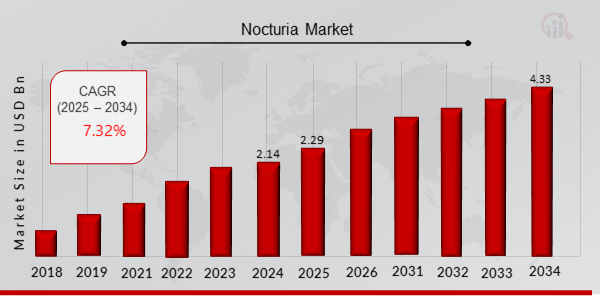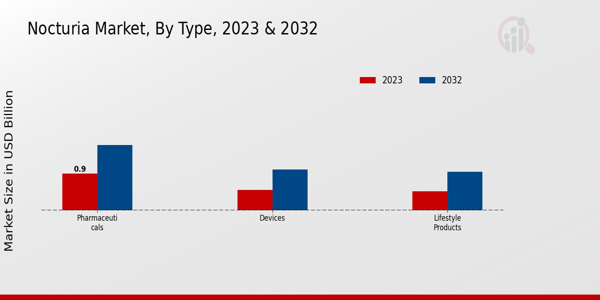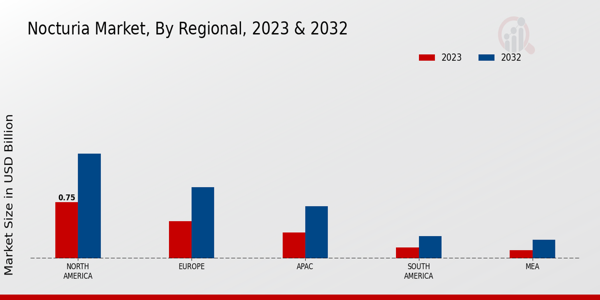Nocturia Market Overview
As per MRFR analysis, the Nocturia Market Size was estimated at 2.14 (USD Billion) in 2024. The Nocturia Market Industry is expected to grow from 2.29 (USD Billion) in 2025 to 4.33 (USD Billion) till 2034, at a CAGR (growth rate) is expected to be around 7.32% during the forecast period (2025 - 2034).
Key Nocturia Market Trends Highlighted
The Nocturia Market is significantly influenced by a range of key drivers, primarily the rising prevalence of urinary disorders linked to aging populations. As the demographic shifts towards older age groups, the incidence of nocturia has increased, prompting a higher demand for effective treatment options. Additionally, growing awareness of the condition among healthcare providers and patients has led to early diagnosis and increased treatment rates. The development of new medications and therapies targeting nocturia is also creating a more favorable landscape for market growth, as innovative solutions promise better patient outcomes.
The nocturia market has many advantages that the appropriate stakeholders can take advantage of. With the introduction of telemedicine, patients who may not have easy access to healthcare facilities can be reached. In addition, other nocturia advertising and educational campaigns can be directed toward patients with the aim of increasing the potential patient population. Further investigation into the causes of nocturia may provide avenues for its treatment. Pharmaceutical/biotech companies and healthcare providers work together to improve patient management strategies and create synergies that can benefit the outcomes. There is, however, a noticeable trend towards the use of more patient-focused treatments in the management of nocturia.
Technological improvements and data-interrogation are accelerating the customization of treatment plans based on individual patient characteristics postulations. There is also growing support for the use of lifestyle changes in conjunction with drug therapies due to a growing awareness amongst patients and practitioners regarding the need for holistic solutions for the management of nocturia. Furthermore, AI and machine learning applications in diagnosis and treatment planning security are changing the management of nocturia and improving management for affected individuals.

Source: Primary Research, Secondary Research, MRFR Database and Analyst Review
Nocturia Market Drivers
Rising Prevalence of Nocturia Among Elderly Population
One of the significant drivers propelling the growth of the Nocturia Market Industry is the increasing prevalence of nocturia among the elderly population. As the population continues to age, the number of individuals suffering from nocturia is rising, given that urinary frequency during the night is a common issue among older adults. This condition can have substantial implications on the quality of life, leading to disrupted sleep patterns, increased fatigue, and higher risks of falls during the night.Such challenges not only affect the individual but also burden caregivers and healthcare systems. Consequently, there is an enhanced focus from pharmaceutical companies and healthcare providers to develop effective treatment options, driving research and development investments in the nocturia segment of the healthcare market. Furthermore, as awareness about nocturia grows and as patients become more proactive in seeking treatment, the demand for innovative solutions will drive market growth.The corresponding strategies adopted by healthcare providers, along with advancements in treatment modalities, will significantly contribute to an expanding market, setting high expectations for a robust increase in revenue in the coming years.
Advancements in Treatment Options and Technologies
Another critical driver influencing the Nocturia Market Industry is the continuous advancements in treatment options and technologies aimed at managing nocturia. With growing research and development efforts, numerous pharmaceutical companies are introducing new and more effective therapies targeting the specific causes of nocturia. This includes the advancement of medications management that cater to various underlying conditions, thereby enhancing treatment efficacy and patient compliance.In addition to pharmaceuticals, technological innovations such as mobile health applications and telemedicine solutions are gaining traction, providing patients with better management tools and resources for controlling nocturia symptoms. The availability of diverse treatment options significantly enhances the overall market potential, as healthcare providers can tailor approaches to meet individual patient needs.
Increased Awareness and Education about Nocturia
The growing awareness and education surrounding nocturia is another pivotal driver for the Nocturia Market Industry. As healthcare professionals and organizations actively engage in campaigns to inform both patients and caregivers about the impact of nocturia, more individuals are likely to recognize their condition and seek suitable treatment. This heightened awareness not only facilitates early diagnosis and intervention but is also instrumental in reducing the stigma associated with nocturia, encouraging more open discussions amongst patients and their healthcare providers.Consequently, as more individuals understand the importance of addressing nocturia and its related implications on health and well-being, there is an increase in the demand for medical assistance and solutions, ultimately propelling market growth.
Nocturia Market Segment Insights
Nocturia Market Type Insights
The Nocturia Market, with a valuation of 1.86 USD Billion in 2023, exhibits a diverse range of offerings categorized by Type, which includes Pharmaceuticals, Devices, and Lifestyle Products. Each segment plays a pivotal role in addressing the condition of nocturia, contributing to the importance of market growth. The Pharmaceuticals category notably dominates this market, holding a significant valuation of 0.9 USD Billion in 2023, and is projected to grow to 1.6 USD Billion by 2032. This segment is essential as it encompasses medications specifically designed to alleviate the symptoms of nocturia, thus addressing the medical needs of a large patient population globally.
In parallel, the Devices segment, valued at 0.5 USD Billion in 2023, is expected to reach 1.0 USD Billion by 2032, showcasing its growing relevance in the market. This segment includes innovative tools and technology created to assist patients in managing their nocturnal symptoms, reinforcing the importance of functional solutions in enhancing patients' quality of life. The growth in this category can be attributed to increased awareness and accessibility of diagnostic and therapeutic devices catering to nocturia.
Furthermore, the Lifestyle Products segment, which has a market valuation of 0.46 USD Billion in 2023 and aims for growth to 0.94 USD Billion by 2032, emphasizes preventative and supportive measures for individuals suffering from nocturia. This segment targets lifestyle modifications, such as dietary changes and sleep aids, thereby fulfilling a critical niche within the overall market. Each of these segments contributes uniquely to the Nocturia Market revenue, showcasing the wide array of solutions available for individuals affected by nocturia.
The overall Nocturia Market Statistics reveal a robust framework of growth driven by demographic factors like aging populations and increasing instances of chronic conditions that lead to nocturia. Simultaneously, market trends reflect a growing shift toward patient-centered care, with an emphasis on personalized solutions promoting comfort and quality of life. Despite the opportunities that lie ahead, challenges such as medication adherence and education on nocturia remain pivotal concerns for stakeholders. To navigate these complexities effectively, the industry must focus on enhancing awareness, developing innovative treatments, and improving patient engagement in order to tap into the full potential of the market. The Nocturia Market data showcases a positive trajectory, indicating a concerted approach towards addressing the medical and lifestyle needs of individuals facing the challenges of nocturia through diversified offerings across all segments.

Source: Primary Research, Secondary Research, MRFR Database and Analyst Review
Nocturia Market Treatment Insights
The Treatment segment of the Nocturia Market is a noteworthy area of focus, contributing significantly to the overall market value, which was valued at 1.86 USD Billion in 2023. This segment encompasses various approaches, including medication, surgery, behavioral therapy, and dietary changes, each playing an essential role in addressing nocturia. Medication remains a key driver, often preferred due to its non-invasive nature and efficiency in managing symptoms, thereby capturing a majority of market attention. Surgery is chosen in more severe cases, offering long-term solutions, while behavioral therapy and dietary changes are recognized for their effectiveness in lifestyle modifications, showcasing a holistic approach to treatment.
The increasing prevalence of nocturia, coupled with rising awareness about its impacts on quality of life, fuels the growth of this segment. However, challenges such as medication side effects and lifestyle adherence persist. Overall, the Nocturia Market data reflects a dynamic environment with growth opportunities, particularly as innovations in treatment methodologies continue to emerge in response to evolving patient needs and preferences. The Nocturia Market statistics indicate a robust trajectory for this segment over the forecast period.
Nocturia Market End User Insights
The Nocturia Market has shown significant evolution, particularly within the End User segment, which plays a crucial role in addressing the growing prevalence of nocturia. In 2023, the overall market was valued at 1.86 billion USD, reflecting a strong demand driven by increasing awareness and technological advancements in treatment options. Among the various categories, hospitals emerge as a significant contributor, offering specialized care and resources for nocturia patients. Home care services are also gaining traction as more patients seek convenience and personalized treatment options from the comfort of their homes.
Additionally, clinics serve as vital points of access for patients, facilitating early diagnosis and intervention. The importance of these settings in the Nocturia Market is underscored by their considerable impact on patient outcomes and satisfaction, as well as their response to the growing need for nocturia management solutions. Furthermore, ongoing market growth may be fueled by advancements in medical technologies and a rising geriatric population, creating ample opportunities for stakeholders. The Nocturia Market statistics suggest that as the demand for effective management solutions rises, these end-user segments will play an increasingly pivotal role in shaping market dynamics.
Nocturia Market Gender Insights
In 2023, the Nocturia Market revenue was valued at 1.86 billion USD, and this market continues to show promising growth. The segmentation of the market by Gender indicates a notable interest in the varying impacts of nocturia on different demographics. Males generally represent a significant proportion of the market, often experiencing higher severity and frequency of symptoms, thus driving demand for targeted treatments. Meanwhile, females account for a substantial share as well, with factors such as hormonal changes and urinary tract health impacting their experience with nocturia.
The interplay of these gender dynamics reveals important opportunities for market growth, as understanding these differences can lead to enhanced therapeutic approaches and effective management strategies. The ongoing research into preferences and responses among genders further contributes to the development of tailored solutions that meet the diverse needs within the Nocturia Market segmentation. Both males and females present unique challenges and opportunities, shaping the landscape of this industry and driving it toward a robust advancement in the coming years.
Nocturia Market Regional Insights
The Nocturia Market is poised for substantial growth, driven by increasing awareness and demand for effective treatment options. In 2023, North America emerged as the leading region, valued at 0.75 USD Billion, holding a majority share due to advanced healthcare infrastructure and higher prevalence. Europe follows with a valuation of 0.5 USD Billion, benefiting from ongoing research and development efforts. The APAC region, valued at 0.35 USD Billion, shows significant potential for growth as healthcare access improves, catering to a large population base.
n contrast, South America and MEA, valued at 0.15 USD Billion and 0.11 USD Billion, respectively, represent smaller markets but are essential for overall market expansion due to rising healthcare investments and awareness. From 2023 to 2032, the growing focus on nocturia management and treatment options will contribute to the regional segmentation's significant role in the expansion of the Nocturia Market revenue. Overall, the market growth in these regions reflects varying levels of healthcare accessibility, highlighting opportunities and challenges within the Nocturia Market industry.

Source: Primary Research, Secondary Research, MRFR Database and Analyst Review
Nocturia Market Key Players and Competitive Insights
The Nocturia Market is experiencing significant growth driven by an increasing prevalence of nocturia among various demographic groups, particularly the elderly. The competitive landscape is characterized by a mix of pharmaceutical companies that are actively involved in developing and marketing innovative therapeutic solutions aimed at alleviating the symptoms of this condition. The market is influenced by various factors, such as the rising awareness about nocturia, the development of novel formulations, and the integration of advanced technologies in treatment options. As research continues to advance our understanding of nocturia, companies are focusing their efforts on tailored solutions that not only address symptoms but also focus on improving the overall quality of life for patients.Merck and Co hold a prominent position within the Nocturia Market. The company is renowned for its research-driven approach and commitment to innovation, which positions it favorably against its competitors.
Merck and Co is particularly recognized for its robust pipeline of potential treatments targeting nocturia, focusing on scientific advancements that enhance the effectiveness and safety profiles of its products. Additionally, the company's strong presence allows it to effectively tap into various markets, catering to a diverse range of patient needs. With its established reputation in the healthcare industry and ongoing investment in research, Merck and Co. are well-positioned to reinforce its leadership in the nocturia segment, contributing to improved patient outcomes.Pfizer is another key player in the Nocturia Market, leveraging its expansive portfolio and strong brand equity to address the challenges presented by this condition. The company's strategic initiatives include collaborations and partnerships aimed at enhancing research and development activities specific to nocturia treatment. Pfizer is recognized for its commitment to innovation, focusing on the integration of cutting-edge technology to deliver patient-centric solutions. Its extensive experience in pharmaceuticals, combined with a deep understanding of market dynamics, enables Pfizer to effectively promote its nocturia-related therapies across various regions. By prioritizing both efficacy and safety in its product offerings, Pfizer aims to meet the evolving demands of healthcare providers and patients alike within the nocturia landscape.
Key Companies in the Nocturia Market Include:
Nocturia Market Industry Developments
The Nocturia Market has witnessed significant developments recently, particularly in drug research and patient management strategies. Companies like Merck & Co. and Pfizer have been actively engaged in advancing their therapeutic offerings, focusing on improving efficacy and tolerability in nocturia treatments. Astellas Pharma has also entered new phases in clinical trials for its innovative therapies, contributing to a more competitive landscape. Notably, Johnson & Johnson and AbbVie have reported increased collaborations aimed at enhancing patient outcomes in nocturea management. While there have been no major publicized mergers or acquisitions directly linking the aforementioned companies in this sector, various strategic partnerships are emerging to bolster research and development pipelines.
Additionally, market valuation growth is being observed, fueled by increased awareness of nocturia as a significant health issue. This growth is positively impacting the market, leading to enhanced investments in treatment solutions and technologies by key players like Eli Lilly, Teva Pharmaceutical Industries, and AstraZeneca. An uptick in demand for effective treatment options is anticipated to further drive market expansion, with an emphasis on efficacy and patient adherence.
Nocturia Market Segmentation Insights
Nocturia Market Type Outlook
-
Pharmaceuticals
-
Devices
-
Lifestyle Products
Nocturia Market Treatment Outlook
-
Medication
-
Surgery
-
Behavioral Therapy
-
Dietary Changes
Nocturia Market End User Outlook
-
Hospitals
-
Home Care
-
Clinics
Nocturia Market Gender Outlook
Nocturia Market Regional Outlook
-
North America
-
Europe
-
South America
-
Asia Pacific
-
Middle East and Africa
| Report Attribute/Metric |
Details |
|
Market Size 2024
|
2.14 (USD Billion)
|
|
Market Size 2025
|
2.29 (USD Billion)
|
|
Market Size 2034
|
4.33 (USD Billion)
|
|
Compound Annual Growth Rate (CAGR)
|
7.32 % (2025 - 2034)
|
|
Report Coverage
|
Revenue Forecast, Competitive Landscape, Growth Factors, and Trends
|
|
Base Year
|
2024
|
|
Market Forecast Period
|
2025 - 2034
|
|
Historical Data
|
2020 - 2024
|
| Market Forecast Units |
USD Billion |
| Key Companies Profiled |
Merck and Co, Pfizer, Astellas Pharma, Eli Lilly, Baxter International, AbbVie, Teva Pharmaceutical Industries, Sandoz, Sanofi, Holly Pharmaceuticals, Boehringer Ingelheim, AstraZeneca, Novartis, Ferring Pharmaceuticals, Johnson and Johnson |
| Segments Covered |
Type, Treatment, End User, Gender, Regional |
| Key Market Opportunities |
Increased prevalence of chronic conditions, Rising aging population, Demand for non-invasive treatments, Advancements in drug development, Growing awareness of nocturia |
| Key Market Dynamics |
Aging population, Increasing prevalence of diabetes, Rising awareness about treatment options, Advances in drug formulations, Growing demand for sleep remedies |
| Countries Covered |
North America, Europe, APAC, South America, MEA |
Frequently Asked Questions (FAQ) :
The Nocturia Market is expected to be valued at 4.33 USD Billion in 2034.
The expected CAGR for the Nocturia Market from 2025 to 2034 is 7.3%.
North America holds the largest market share with a value of 0.75 USD Billion in 2023.
The Pharmaceuticals segment is expected to be valued at 1.6 USD Billion by 2032.
Key players in the market include Merck, Pfizer, Astellas Pharma, and Eli Lilly, among others.
The Devices segment is expected to grow to 1.0 USD Billion by 2032.
The APAC region is projected to reach a market size of 0.7 USD Billion by 2032.
The Lifestyle Products segment is expected to be valued at 0.94 USD Billion in 2032.
Key growth drivers include increasing awareness of nocturia symptoms and advancements in treatment options.
The South American region is projected to have a market size of 0.3 USD Billion by 2032.

















